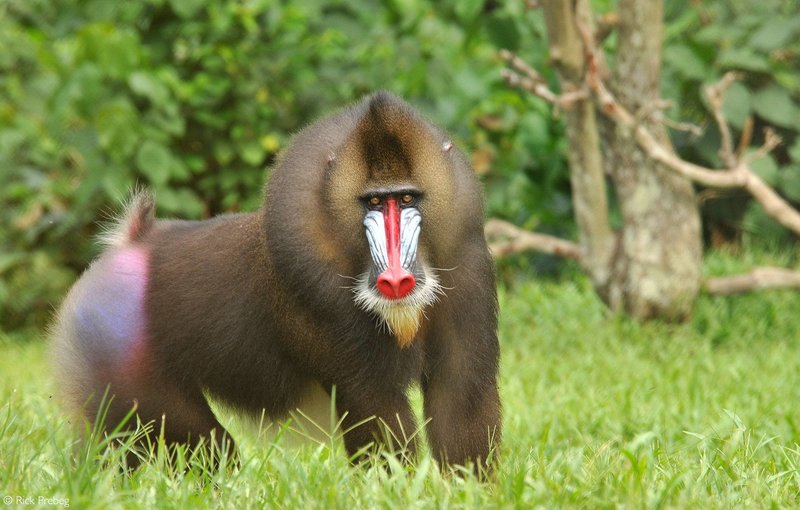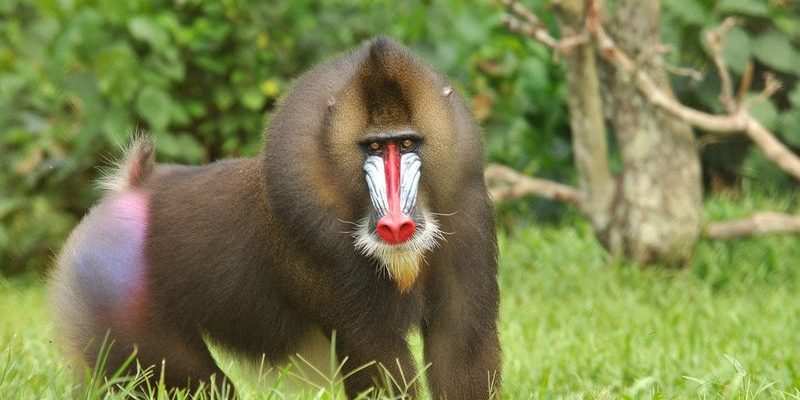
The mandrill is one of the most visually striking primates in the world, known for its vibrant colors and impressive size. Imagine a creature with a big, expressive face painted in bold blues, reds, and yellows, all topped off with a monkey’s playful curiosity. These fascinating animals belong to the same family as baboons, yet their appearance sets them apart, making them a spectacle in their natural habitat. You might picture them swinging through the trees of Africa’s tropical rainforests, a sight that can easily capture anyone’s attention.
What’s particularly interesting about mandrills is their social structure. They live in large groups called troops and exhibit complex social behaviors, much like humans. With a mix of cooperation and competition, these creatures navigate their social hierarchies in both amusing and impressive ways. This social dynamic is essential for their survival and is something you might find fascinating if you’re curious about animal behavior.
Physical Characteristics
Mandrills are not just known for their vibrant colors; they also have impressive physical traits that help them thrive in their environment. Adult males can weigh between 40 to 100 pounds and measure about 2 to 3 feet in length, including their tails. Their large size is complemented by these vibrant facial markings, which not only serve to attract mates but also help establish dominance within their troops. Imagine such a creature strutting around the jungle, showcasing its colorful features like a walking piece of art!
One of the most striking features of a mandrill is its face. The male has a bright blue and red snout, along with contrasting colors around the eyes, making its expressions even more pronounced. It’s almost as if these colors are nature’s way of saying, “Look at me!” This colorful display is not just for show; it plays a role in communication among mandrills. Research shows that the intensity of these colors can indicate the health and social status of the individual.
Habitat and Range
You’ll find mandrills predominantly in the rainforests of Central Africa, especially in countries like Gabon, Cameroon, and the Republic of the Congo. These lush environments provide not just shelter but also a rich source of food. Mandrills prefer dense forests with both canopy and undergrowth, where they can forage for fruits, seeds, and small animals. Their habitat is crucial for their survival, as it influences everything from their diet to their social interactions.
Interestingly, mandrills are also known to venture into more open areas, and this adaptability allows them to thrive in varying ecological conditions. However, their primary preference remains the dense, tropical rainforests. Sadly, the destruction of these habitats due to logging and agriculture poses a significant threat to their survival. As humans continue to encroach on these forests, we risk losing not only the mandrills but also countless other species that depend on these ecosystems.
Diet and Eating Habits
Mandrills are omnivores, which means their diet consists of both plant matter and small animals. They primarily feed on fruits, which make up a large part of their diet, alongside leaves, seeds, and nuts. When fruit is in season, you might find them happily munching away, using their strong jaws to crack open hard shells. They can also occasionally hunt small insects or rodents, adding a protein component to their meals.
What’s fascinating is how they forage. Mandrills are social eaters and often hunt for food in groups. This not only increases their chances of finding food but also strengthens their social bonds. Imagine a group of these colorful creatures working together to find a particularly tasty fruit tree — it’s a delightful scene to picture! This social aspect of their feeding habits is crucial for their survival in the wild.
Social Structure and Behavior
Mandrills live in complex social structures that can include dozens of individuals. Troops are often led by a dominant male, who maintains his position through displays of strength and color. You might find these males acting somewhat like royalty, showcasing their beautiful faces and posturing to impress potential mates and assert dominance over rivals. Females, on the other hand, are usually responsible for the young and play a significant role in the troop’s social dynamics.
Within these groups, mandrills engage in various social behaviors, from grooming one another to establishing hierarchies. Grooming is especially important; it strengthens social bonds and helps reduce stress. You can imagine how this seemingly simple act of picking through fur can have profound implications for relationships within the troop. This social cooperation is essential for their survival, helping mitigate conflicts and enhancing group cohesion.
Conservation Status
Unfortunately, mandrills face significant threats in their natural habitat. Habitat destruction, poaching, and hunting have all contributed to their declining populations. The International Union for Conservation of Nature (IUCN) lists mandrills as vulnerable, highlighting the urgent need for conservation efforts. These creatures symbolize the beauty of biodiversity, and losing them would be a significant blow to our planet’s ecological richness.
Conservation efforts are in place to protect mandrills and their habitats. Various organizations are working to safeguard the rainforests where they live while promoting sustainable practices that benefit both wildlife and local communities. You might find it inspiring to see how some communities are coming together to protect these magnificent animals, showcasing that collective action can lead to positive change.
Interesting Facts
There’s so much more to mandrills than meets the eye! Here are some fascinating tidbits that might surprise you:
- Color Communication: The intensity of a mandrill’s facial coloration can signal its health and status.
- Unique Social Groups: Troops can include up to 200 individual mandrills, showcasing complex social interactions.
- Endurance and Speed: While not the fastest, mandrills can reach speeds of up to 30 miles per hour in short bursts when startled.
- Active Habits: Mandrills are diurnal, meaning they’re most active during the day.
Table of Mandrill Facts
| Size: | 2 to 3 feet in length (including tail) |
| Weight: | 40 to 100 pounds |
| Habitat: | Tropical rainforests of Central Africa |
| Diet: | Fruits, seeds, small animals, insects |
| Social Structure: | Live in troops of up to 200 individuals |
| Conservation Status: | Vulnerable |
FAQ
What is the lifespan of a mandrill?
In the wild, mandrills typically live around 20 to 30 years, although some have been known to live longer in captivity. Their lifespan can be influenced by factors such as diet, habitat quality, and the presence of predators. Just like with many animals, a safe and healthy environment can lead to a longer life.
Are mandrills aggressive?
Mandrills can display aggression, especially when establishing dominance within their troops. Males often engage in displays or fights to assert their position. However, they’re also capable of forming strong social bonds, and many interactions within a troop are peaceful. Understanding their social dynamics helps clarify when aggression might occur.
Do mandrills have any natural predators?
Yes, mandrills face threats from various predators in their natural habitat. Large cats, such as leopards, and other carnivorous mammals can pose a risk, particularly to young or weak individuals. Their social structure helps mitigate these threats, as they can alert each other to danger.
Can mandrills swim?
Although not known for being great swimmers, mandrills can swim if necessary. They prefer to stay in trees, but if they need to cross rivers or streams in their range, they will take the plunge. Their ability to adapt to various environments aids their survival.
What do mandrills communicate about?
Mandrills use a variety of vocalizations, facial expressions, and body language to communicate. They convey messages about mating readiness, social status, or warnings about predators. Their expressive faces, influenced by their colorful features, play a significant role in non-verbal communication.
How do mandrills care for their young?
Female mandrills take on the primary caregiver role for their young. Mothers nurse and protect their infants, teaching them essential survival skills as they grow. Young mandrills start to explore their surroundings early on, learning about their environment and social dynamics through observation and interaction.
Are mandrills social creatures?
Absolutely! Mandrills are highly social animals that thrive in large troops. Their social interactions are important for their well-being, allowing them to form bonds and establish hierarchies. These interactions also play a key role in their survival, reducing stress and enhancing cooperation.
How can we help conserve mandrills?
Supporting organizations that focus on wildlife conservation, promoting sustainable practices, and raising awareness about the threats mandrills face can significantly contribute to their protection. Even small actions, like supporting eco-friendly products or participating in conservation campaigns, can have a lasting impact.
What role do mandrills play in their ecosystem?
Mandrills contribute to their ecosystems by helping with seed dispersal through their fruit-based diet. As they move through the rainforest, they consume fruits and later excrete seeds, aiding in plant growth and forest regeneration. This makes them important players in maintaining the health of their habitats.
Can mandrills be kept as pets?
Keeping a mandrill as a pet is not practical or humane. They are wild animals with complex social, dietary, and environmental needs that cannot be met in a home setting. It’s best to appreciate them in their natural habitats and support conservation efforts instead.
What is the origin of the name ‘mandrill’?
The name “mandrill” comes from the combination of two Dutch words: “man” (man) and “dril” (a kind of baboon). This reflects its classification as part of the baboon family and its distinct characteristics. It’s a name that captures both its uniqueness and its place in the primate family tree.
How do mandrills interact with other animals?
Mandrills usually maintain a distance from other animal species, but they can sometimes coexist with other primates or animals in their environment. Their social structure influences how they interact, often resulting in a mix of competition and cooperation. This dynamic showcases their adaptability as well as their social intelligence.
What are the main threats to mandrills today?
The primary threats to mandrills include habitat destruction due to logging and agricultural expansion, poaching, and hunting for bushmeat. As these threats continue to escalate, effective conservation measures are crucial to protect mandrills and their environments from further decline.

